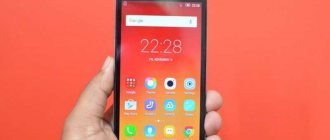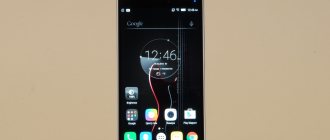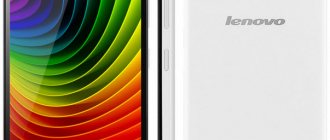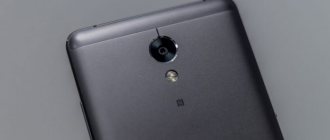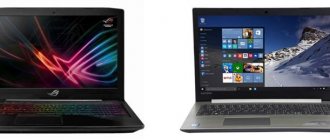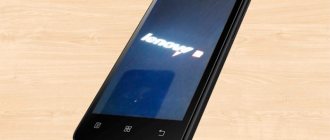I haven't gotten my hands on flagships lately. At all. And this time, the flagship version of the super-cool Lenovo Vibe X3 went to Lyapa and Moskalets to be torn to pieces, and I was pleased with the only Lite version. And I’m like, guys, are you kidding me? Why do I even need it? And they’re like, just try it, maybe it’s not as bad as you think! In general, I was offended, but I took it. And it turned out that the Lenovo Vibe X3 Lite is overall a very pleasant device!
Just doing a smartphone review didn’t seem like a good enough idea to me. It goes without saying that the light version of the flagship was cut down here, removed here, simplified here to make it look like the leader, but cheaper. So I took Lite, gave up my main smartphone and spent almost a month with it. It was a complete operating experience, with all the details.
Differences
The most important point to focus on when choosing between economy and flagship. In our specific example, it is fundamental, because the manufacturers carefully called the gadget a lightweight version of the flagship, but it also bears the common name A7010. The devices are identical in body and screen quality, but the performance and autonomy are not even close. Regarding sound, of course, I’m not such a locator as Andrey, but it seems to me that he would not be proud of it. At maximum volume it locks and wheezes. But there are literally twice as many gradations in the track as on the OnePlus One. And it turns out that you press the volume rocker a hundred times (figuratively), but it keeps getting quiet and quiet, and then bam! and sharply loud. And very loud at that. Suddenly.
- Dimensions: 153.6×76.5×9.15 mm.
- Weight: 156 g
- Operating system: Android 5.1 Lollipop.
- Processor: eight-core 64-bit MediaTek MT6753, Cortex-A53, frequency 1.3 GHz.
- Graphics: Mali-T720MP3.
- Display: IPS, 5.5″, 1920 x 1080 pixels, 401 ppi.
- Memory: 32 GB + microSD up to 128 GB.
- RAM: 2 GB.
- Camera: main – 13 MP, f/2.2, video recording 1080p @30fps, front – 5 MP.
- Two SIM cards in microSIM format.
- Interface connectors: 3.5 mm headphone jack, Micro USB 2.0.
- Battery: Li-Pol battery 3300 mAh.
In short, get ready for the fact that in front of you is a smartphone that will lag. But this is not a reason to close the material, read on. He has a couple of trump cards.
8.5 hours video playback
Lenovo A7010 has a medium-sized battery (3300 mAh), but a fairly economical processor, which ultimately results in a day of work without charging under heavy loads (an hour of games, a couple of hours on the Internet, half an hour of calls and constant synchronization of Facebook, Skype and two email accounts). boxes).
At the same time, at the end of the day in this mode, you will still have 15-20% charge left. If you use the charge more economically, you can count on a couple of days of work.
In our test of continuous video playback at maximum brightness, the smartphone lasted 8.5 hours - a very good result.
Appearance and comfort
Externally, the smart is exactly the same as its older brother - the same body, the same arrangement of elements, just a dual flash on the side, and not under the camera. The white plastic is a little easily soiled, there are no metal sections, and in general you immediately understand that the manufacturer wanted to save money. I don’t blame him for this, but the fact that the internal insert in the microUSB socket does not fit tightly and can “walk” along the notch is unforgivable. And the slot itself is upside down.
Another minus is that the phone is crunchy. To do this, you don’t need to squeeze it as hard as you can. One awkward movement is enough to produce the crunching sound characteristic of many devices with a removable lid. The back part sits on 15 grooves, does not bend under your fingers, but in the upper part it is everywhere, and in the lower part it makes sounds only around the perimeter, which, in theory, should not be. This is unusual.
I liked the appearance and ease of use of the smartphone. It wasn't embarrassing to take it out of my pocket at an event, it looks neat, not some nonsense. On the front (thank you!!) there is no brand inscription, there are two speakers and thin white frames. It is wide at the sides, but they are not sharp and do not cut the palm. That's it, and with all the responsibility characteristic only of Miss Crashtest, I declare that the phone really fits comfortably in the hand. It does not slip out, and with a diagonal of 5.5 inches it does not seem huge. In terms of appearance and ergonomics, I was really satisfied with everything. In addition, it has slots for two SIM cards and an SD card, so I couldn’t be happier (in the second slot I have vodafone, after the experiment was over)
It's cool that even the average person has a fingerprint scanner. Firstly, you quickly get used to it. Lately, out of nowhere, I’ve started to become paranoid about the security of data on my smartphone, so I was really happy about the scanner. Specifically, on my device, you can only enter two fingerprints; I entered both index fingerprints, but it read them correctly every other time. It doesn’t always work if you place your finger sideways, although during the adding process I pressed it against the pad anyway. Even less common if your hands are wet. The prompt to enter your PIN appears after 3 unsuccessful attempts, but don’t give up! I basically finish off the scanner until it counts my fingerprint. The maximum number of attempts before a successful result is 7, but this only happened once. I was very surprised that after you have just entered the fingerprint, and for the first time you try to launch the camera with a standard Android swipe from the right edge, the phone will ask for your finger or password.
Lenovo Vibe X3 - Lenovo's latest flagship
Lenovo's latest flagship... no, I, of course, understand that after that there was at least another, but it seems to me that despite all the quality of the Lenovo P2, it couldn’t even be called a flagship at the time when this long-lasting phone appeared. moral law. As for ZUK and Motorola, everything is simple for me - they differ from Lenovo exactly to the same extent as Sprite and Fanta differ from Coca-Cola... it seems like the manufacturer is the same, and the bottle is similar, but not at all the same.
So, Lenovo Vibe X3 ...
In general, when I was choosing a phone, and the selection procedure was not easy and quite lengthy (you can read a little here), the choice was completely between other models, and I found this one almost by accident. The selection criteria were simple: a phone for work (in my case, these are four active mail accounts, the same number of various social networks, all sorts of Viber, Line and WhatsApp in the amount of five or six, normal work with background applications: open a 30-megabyte pdf and switch from it into an Excel spreadsheet - an absolutely normal task, and at the same time talking on the phone at the same time). In general, this particular mode is much more demanding on hardware than some Need for Speed. So, having overcome the agony of choice, or rather, when I finally got tired of reading tons of text and watching terabytes of videos with reviews (you can watch it live, due to the peculiarities of your region of residence, on a very limited number of devices), I took it and ordered it on that same Aliexpress.
And the seller took it and sent it. It’s a little too suspicious, isn’t it? I’ll say right away - there was also a marriage that changed a lot of things, but not that it ruined it, but more on that at the very end of the story, but for now - all attention only to the phone.
I see a “flagship” only as a combination of the best characteristics on the market. It’s not just that there should be 6 GB of memory or a 51 megapixel camera, but everything in the phone should be at the appropriate level, and this “everything” starts with the packaging (yes, for me, external qualities are no less important than the internal component) .
A huge reinforced bag filled with air, several layers of incomprehensible soft winding - the road from China to us involves, judging by the shipping container, at least a couple of galactic wars... Having unpacked this miracle of packaging, I found a radically different box inside. Blue and white thick cardboard in a “dust jacket” with embossed “X3”. The lid is not removable, but hinged; each component has its own compartment.
Everything is extremely strict, but also very nice and somehow “gentle” or something. I was pleased with the box, to say the least. In addition to the phone itself, the kit includes only a charger (Chinese model, with an adapter for a “normal” outlet) and a microUSB cable. There is also a guarantee and instructions - both in the most widely spoken language in the world - Chinese, of course.
There are no headphones - this is the very case when this is perceived not as savings, but as respect for the buyer - as they say: “To each his own Audio-Technica, to suit his taste and color.” Charger for 2 A, i.e. Logically, the phone should charge quite quickly, it is even possible that the phone even supports the so-called. “fast charging” (most “reviewers” carefully avoided this fact). In fact, yes, it does, but it is disabled in the kernel, so you will either have to install modified firmware (which is not interesting) and charge the battery in 1.5 hours, or be content with what you have and wait “as much as” 2.5 hours. I was pleased, again, that the charger and wire were white, just like the phone. It seems like a small thing, but in Mi5, which is Xiaomi, they are black, which makes me quite nervous.
Now let's talk about the phone itself - it's good! Metal, glass, plastic - a great combination. So, the front panel, in addition to the speaker grilles, is covered with protective glass from Corning - this is that terribly marketing Gorilla Glass, and in revision number “3”. The speaker grilles and the rim of the screen, apparently, are painted metal (but maybe durable plastic - opinions are mixed, but it doesn’t matter - it looks and feels great), the side contour is metal - you can’t argue with that: obvious silvery cold aluminum.
But the back cover is matte, completely non-slippery plastic. The first person to argue that the flagship should be made of glass or metal, let him hold the Mi5 in his hands - after several months of communicating with both, I am firmly convinced: plastic is more practical and no worse (although the elegance of the Mi5, also thanks to the “glass” back cover, at a prohibitive level).
Below is a standard (still) microUSB connector; on top there is a standard (still) 3.5 mm headphone jack, and a standard (a few years ago) infrared port (yes, there was a time when it was present in almost every phone).
Of the others, the only button is power and the volume rocker. There are no smart buttons or buttons, for example, there is no camera launch (which is not good, but not bad at all).
I wonder if the developers designed this or if it happened completely by accident, but here’s a fact: if you hold the phone so that the power button is under your thumb, your index finger will definitely land on the fingerprint scanner, which is located on the back panel!
Moreover, the scanner is somewhat recessed relative to the general surface and it will be difficult not to find it. Based on its location, I’ll note a small IMHO: after using it on the Mi5, where it’s embedded in a mechanical button on the front panel, I know for sure that I like the back better. Many times more. Incomparable. But here the location is very influential - on a couple of other phones I searched for it at random for half a minute.
All components are glued to each other - there are no latches, so it will not be possible to disassemble at home. There are no gaps, no backlash, no creaks - everything is tight, as it should be.
There is also a LED above the screen. It glows white - only white, without options or alternatives (not a single program could do anything about it - and it doesn’t matter whether there is a root), even the low battery is indicated by the same white flashing.
In terms of appearance, I like everything, the only thing is that the black frames around the screen, so beloved by Chinese manufacturers, I don’t like them... but otherwise, it’s great! But let me draw your attention to the fact that the phone is simply huge - it simply does not fit in a small, average hand.
The model is a flagship by the standards of 2015: six-core Snapdragon 808 processor from Qualcomm, 3 GB of RAM, 21 megapixel camera, infrared port, NFC, OTG, FullHD screen. It was difficult to think of anything more at that time (even now I have a hard time imagining tasks that could throw this system “out of balance”).
In general, as far as I remember, the 808 Snap never became popular - after dozens of models on the 800/801 socket, only a few (on the fingers of one hand) options with the 808 on board appeared in the world, among which the most famous are: Nokia 950, Nexus 5x yes LG G4. Oh yes - also Mi4c - this is so as not to offend representatives of the “coming of Xiaomi” sect. I think at that time everyone was waiting for the 810 Snapdragon, which, suddenly, turned out to be so fast that along with it came instructions for using fire extinguishers and a reminder with the telephone number “01”.
So, the 808 Snapdragon works according to a 4+2 scheme: four “slow” cores with a maximum frequency of 1440 MHz (little) and two “fast” ones with a maximum frequency of 1824 MHz (big).
This scheme allows you to spare the battery in undemanding tasks and complete complex tasks as quickly as possible. The architecture is 64-bit, which is good - the main thing is that there is enough RAM, but there are no problems with this either.
So the RAM is 3 GB LPDDR3, which is enough for almost any task. The “defects” relative to the fourth edition of this standard are practically not felt (I’m talking about this in comparison with Mi5).
In a word, a normal flagship for 2015 and even half of 2021, which has still not lost its computing power (obsolescence, of course, is a thing).
It's time to turn it on, right?
The excellent screen with a resolution of 1080p and a diagonal of 5.5 inches is covered with some kind of oleophobic coating, which has either worn off or become dirty over six months - the screen is still slippery, but fingerprints are already collected, although not as readily as on most current smartphones.
The colors are close to real, there are no obvious “embellishments” or distortions. Auto-brightness works great, especially in the dark - the screen doesn’t dazzle at all - they can’t even illuminate anything.
But in the sun there is not always enough brightness. Sometimes it’s even really lacking. No, everything remains readable and you can always understand what is happening on the screen, but maximum brightness is not enough for comfortable use.
The situation is partly corrected by a switch in the screen settings - “Smart Brightness” - in the sun the bright mode will be automatically turned on.
10 touches are supported simultaneously - you can point all your fingers at the screen at once... why - I don’t know, but cool! (I won’t insert a screenshot on principle - here they take my word for it.)
The control keys are touch-sensitive, not on-screen (although we all know that by replacing “false” with “true” in just one place you can enable them on the screen), without backlighting and without the possibility of reassignment using standard means - the only thing is that you can select the behavior in the settings “Menu” buttons: “Recent” or “Menu”.
And now about the most interesting thing - the phone is from China, how is it in general? How's the firmware? How to translate the hieroglyph “Soup” into Russian?
So, a phone with international firmware has arrived! Even more - the international firmware of the latest, at the time of sale, Android - sixth. Accordingly, not a single hieroglyph, not a single English word - after switching to Russian (of course) - everything is as if the smartphone was bought in a nearby Euroset or Megafon store.
All “our” frequencies and bands are supported, there are no problems with Wi-Fi, network, SIM cards or anything else.
Since I started talking about the firmware, I’ll continue - everything works under the proprietary Vibe shell. Here, again, is my humble opinion - Lenovo managed not to spoil it. So, for the first time I “met” it back in 2013 on the Lenovo S820 and even then I appreciated it.
What I like is that all the “unique” functions are placed in a separate menu - “Special”, while the general structure remains the same and anyone who has previously seen an Android smartphone can easily figure it out - everything is the same (here I remember my epic with setting up one day Samsung Note 2, and A5 2021 - three smartphones from Samsung and all have radically different menu structures).
The functions are interesting and necessary: turn sound, double-tap unlocking, “In your pocket” mode - I don’t think any comments are needed - any serious phone cannot do without them. Another thing is that when they are not there (hello, Mi5) everything is much sadder.
O - when you long press it, it will disappear, leaving only a notification in the curtain. Trifle? But no - digressing from the topic, I’ll say that in Xiaomi the button is not hidden in any way, which makes the work terribly complicated.
The pocket protection mode works in the same way - if the phone is in your pocket and the sensor is closed, it will not turn on. Not at all. But as soon as the sensor is released, the unlocking protection will be removed automatically, without the need to press any combinations.
But the first thing that catches your eye is your own shell. Everything here is hackneyed and familiar, there is no AppDrawer (that’s the “Menu”), all programs are on the desktops, but the main thing is the ability to install many themes that change absolutely everything, but what’s even more important (the most important thing, so to speak) is that the themes are almost everyone is beautiful and conveniently receptive!
Just in case: it was not the status bar that suddenly turned ugly orange - it was the energy saving mode that turned on.
In general, in the desktop settings you can choose, in addition to the traditional “transitions”, the shell type: Vibe or “Standard”. So, in the second case, the application menu will return - for example, I’m somehow more accustomed to it.
We also replaced the phone book with Lenov’s IdeaFriend. The thing is quite convenient: there is a black list and conversation recording, a full-fledged search in Russian “T9”, advanced filter parameters with “understanding” of groups - not much different from the “standard” one, but somewhat more convenient, although it is difficult to distinguish them visually.
Yes, they also added the ability to customize the “curtain” normally, so you can not only select and organize shortcuts, but also remove some of them altogether, and, in general, select their number.
The rest is the usual full, uncut Android! A full developer menu, a complete package of Google programs (in the micro edition, it seems - without all these “Planet” and so on, but with a market and “Okay, Google”).
And now for some interesting things, cameras and other games!
Let's start with something simple - a fingerprint scanner
. Without a twinge of conscience - it’s almost perfect (I compare this with Mi5 and S6 from Samsung). Not only does it always work without recognition errors, but also the unlocking happens instantly - the lock screen does not appear for a moment. And I already talked about its convenient location. By the way, initially, in Android 5 only 2 fingerprints were supported. Considering the location of the scanner, no more is needed - it’s hard to imagine how otherwise, except for the index fingers, you can even get there, but this only applies to a single-user scheme - if at least two people need to unlock the phone, I would like more fingerprints... Here in 6- On Android they were increased to the standard 5.
Yes, you can take pictures with the fingerprint sensor while the camera is running (as noted above).
Works fully and Google Smart Lock
- such a thing that during certain events, locking the screen with a password, PIN code or fingerprint does not turn on. I just set it up that it’s not at home, and when the phone is next to me it’s not there either, and I also set up face unlocking - of course, these actions didn’t add security, but they did (let’s say) increase the ease of use.
Let's go further - infrared port
. Lenovo didn’t bother at all - in my opinion, the best program was preinstalled - Peel Remote (which also shows a convenient widget with “fast” programs). It works, perhaps, with any equipment - I tried it with an LG TV and a Haier air conditioner (this was also found in the program).
NFC
. To put it simply, during the initial setup, if you touch one phone to another, all account settings will be transferred (I tried it between Lenovo and, you already know, Xiaomi). It’s more difficult to check, for example, the balance on the “pass”... True, Troika is not supported due to the trickiness of the protocol...
Sony Xperia tags were easily recognized. Lenovo considered it necessary to build in a program to configure them (in the sense of any labels), and not trust this action to third-party software. So, you can assign a program launch, a call to a contact, or something else useful to a tag - everything will work when you contact the tag.
The most difficult thing - the payment - I couldn’t check, but judging by the reviews, it works.
Pedometer. There is such a thing. Of course, you can install a third-party program on any phone - but how it will work is unknown, I’ve been experimenting for a long time - the result is always unpredictable. But here everything is normal - there is a program that measures our steps, counts calories and makes us happy with our achievements. The error of the pedometer is 2 steps per 100 steps - that’s what I calculated myself, or 50 steps per 3000 steps in comparison with the Samsung S6. So, not S Health, of course, but a very good option.
Music. Actually, this is the “unique feature” that marketers have been pushing for. The situation turned out to be most absurd: having launched a product absolutely worthy in every sense on the market, but focusing on sound, Lenovo, it seems to me, lost a fair share of customers. So, 90% of reviews began with the words: “Review of a music phone...” - and who needs a music phone? Only a few... I myself didn’t pay attention to it for this reason - I know that in our time, if the phone is “musical”, then the camera takes disgusting pictures, and the fingerprint is larger for beauty. Fortunately, that's not the case here, but let's get back to the sound.
The sound is really great. In headphones, even simple ones from Sony, in comparison with Sony ZL and Xiaomi Mi5 - not even close - the difference is immediately audible, both in volume and saturation (and these are not even the unfortunate AKGs). The speakers, and there are actually two of them - top and bottom, produce sound that is just as superior to that of most phones (and here’s what I really liked: the speakers are located in such a way that no matter how you pick up the phone, you won’t be able to drown out the sound - it’s always loud and loud, this feature helps a lot during games), but let's face it - listening to music in this way is heresy.
The only remark is that Lenovo didn’t bother to preinstall the music player for some reason. Either I’ve become lazy or something else, but it’s strange, considering that Lenovo Music is a very worthy program, the peak of its development came just at the time of the release of Vibe X3 (here is the link). But they added all sorts of improvements and settings - they didn’t skimp.
And there is also a trick (even a life hack, wow!). Download this program (it helps to trigger the actions inherent in the program/firmware, but to which the developers for one reason or another did not give access), find the “High-quality audio” program, click “View”, select “Headset settings”, and then, from the entire list of headphones - HD650. The bottom line is that these particular “ears” are designed for 300 Ohms, and accordingly the phone removes restrictions from the DAC in order to “pump up” them. The volume increases significantly, and all this without root access!
Yes, not all players work with a built-in DAC, the list can be found here.
The sound settings have everything you need: separate assignment of melody to each card, increasing volume, “In your pocket” mode.
OTG
- available and working - you can connect a flash drive and watch movies or, conversely, work with all sorts of tables and other presentations.
Glove mode
It turns on only when the charger is disconnected (I wonder why), and not only turns on, but also works! At hand (luckily spring this year is not too different from winter) there were quite a lot of different gloves: fabric, cashmere, leather, something synthetic rubber (and all this was never special, not for smartphones) - and with all The screen coped well with this joy and responded.
I’ll also say something about the SIM card slot. Two nano cards are supported. One of them can be replaced with a memory card. No matter how bad. The good thing is that the “sandwich” is supported - home-grown Kulibins, if desired, in about 10 minutes will make a thing where there is a memory card on one side and a SIM card on the other (I will respect the copyright and give a link)
.
Hot swapping of SIM cards is supported. Cards are detected without turning off the phone in 5-7 seconds.
Navigation
. With this, in general, everything is almost super. GPS, GLONASS and Chinese similar data are supported. Determines the position with an accuracy of 3 meters (i.e. using satellites, not a-GPS) in 10-15 seconds upon first launch.
The track is smooth, stable, without breaks when turning off the screen, traveling in a car or anything else... The car track is almost perfectly smooth.
Pedestrian - it lags a little, but is also stable, there is swaying within a meter or three. At the same time, this Brownian movement in the screenshot also happened in reality - it’s not the phone that has the problem, let’s say so.
Camera
. Finally, right? The most important thing. And there’s nothing to say... Camera - 21 megapixels. I, as an adult, well-read and remembering something from the physics of light course, understand that megapixels are just the maximum size of a photo (we multiply the vertical resolution by the horizontal and get those same megapixels) and have, well, a very significant impact on the actual quality of photographs indirect relationship (whether it’s a matter of lenses, matrix size and other smart things). But in this case the camera is really good. It’s still a long way from excellent, but for the home it’s just what you need.
So, the auto mode perfectly works out general plans and all sorts of subtleties in the form of a beautiful sky.
In the same way, he can easily take macro photographs, and he can even “catch” branches with flowers swaying from the wind.
In general, the colors in the photo are not embellished, very close to their natural shade - it doesn’t look as impressive as in the photo from Mi5, where the colors are clearly “carefully refined with a file,” but somehow it’s more correct.
A simple white color looks good on the camera - it doesn’t seem to turn it yellow or blue...
Autofocus is present, which is natural. But the camera easily masters focusing by tapping on the screen - in a second, the focus literally shifts from “macro” to “infinity” (or somewhere else, depending on needs).
In difficult situations (at night, shooting against the light), the pictures are also of quite decent quality.
The only difficult moment is shooting in the dark with flash - somehow there is too much "soap" in the photo, and, perhaps, it copes with twilight quite poorly - when it is not light anymore, but not dark either...
In general, there are a lot of plots, presets, effects, with some of which there is clearly something wrong. Here is a photo of the HDR mode in the “City” scene (yes, there are several scenes even for HDR alone):
Something's not right, right? But if you reset the plot to “Portrait”, then everything gets better:
A few more shots from different plans:
The front camera takes pictures just fine for a front camera.
Yes, by the way, the camera also has a manual mode with the ability to set shutter speed, white balance and focus manually.
The video camera is capable of shooting with a resolution of up to 4K inclusive, there is a video stabilization system (digital, optical - not proven - at the level of rumors and comparisons of results) and interesting features in the form of slow-motion and fast-motion shooting modes.
Conversation and communication
. Three microphones and powerful speakers ensure normal communication. For the first time in a number of phones, I like the audibility of the interlocutor, not after a month of getting used to it, but immediately - clearly, loudly, the voice is heard nearby, and not from a metal basement.
But the microphones on my phone didn’t work out - as it turned out after two weeks of use, my interlocutors couldn’t hear me - something wasn’t working there. Despite the fact that communication via VoIP (Skype, Viber, Line) is problem-free - this is exactly how I communicated for those very two weeks, which is why the issue of a non-working microphone did not come to light immediately.
It was not possible to repair it - the problem is deep, somewhere in the motherboard path, and, to be honest, I didn’t want to - the seller immediately after contacting me returned the entire cost of the phone...
Finally, a word about performance.
. So, the performance of Antutu 6.2.1 is not impressive at all - some 74,000 (59,000 in 5.7.1) parrots.
In other benchmarks - the same thing - average, no more.
The only 3Dmark pleased with its results:
What I liked was the cooling system: with significant heating during tests, within a minute the system cooled down to a normal level.
Oh, by the way, before I forget: the phone holds its charge steadily for a day - maybe up to two, if you don’t strain it too much (but games can completely charge you in 5-7 hours).
But since I’ve been using the phone for six months now, all these tests are not depressing at all - I know the real possibilities not in “synthetics”, but in real life! The phone easily handles all my emails, social networks, it doesn’t unload programs for the sake of free memory space, it doesn’t slow down, it doesn’t make me wait for several seconds to pick up the phone...
For those who need games, please: everything I installed runs smoothly (in the photo there are screenshots of games to assess the image quality - as it turned out, many people understand the level of settings from the picture). Thus, Modern Kombat 5 at maximum settings never made the picture even twitch, not to mention the brakes. If you like to shoot, then you can just as easily try out Nova: Legacy.
If you want the legendary Injustice (not the second one yet) - well, bet the maximum and play: Scorpio and Green Arrow “waving” extremely beautifully and playfully.
Fans of car racing can easily install Asphalt 8 or Real Racing 3 - it doesn’t slow down at maximum, that’s true.
All sorts of “flying” and “swimming” games, various fashionable games like Mafia 3, Sandstorm or King Arthur are also easy to play...
Even Freeblade, which is based in the Warhammer 40,000 universe, is beautiful, large-scale and fast...
In conclusion, I would like to note that the phone has excellent root access, xPosed works with all sorts of LuckyPatcher, there is TWRP and several firmwares: from Chinese to European, including a semi-working (there are no drivers for a dedicated DAC) Android 7 .
Opinion
It's a shame that Lenovo, having finally released a balanced phone capable of bearing the title of "flagship", stopped and switched somewhere else. Their subsequent models are worthy of the title of good phones, but nothing more. And now, rumors are circulating about the abandonment of the brand in favor of Motorola. As for the other brands of the group, the development of ZUK is somewhat sluggish, and their phones are by no means flagships: no NFC, no infrared port (little things, but just as an indicator - this is what I said at the beginning: a flagship is not only 820 (835) Qualcomm), and Motorola, with its rather high price, can surprise only with a modular system and case materials.
As for my phone - due to the microphone not working, they returned all the money to me (I didn’t ask for 99 cents), so I got a mini-tablet (PDA, as they said 10 years ago) for 1 dollar, but I didn’t stop there - it’s now official The Lenovo store in Russia is selling the Vibe X3 for 13,000 with delivery - this is exactly the amount that I paid for it in China, and you know what - as soon as I come up with a delivery method (there is a courier to the door only from the real options), I will immediately get it I’ll order it, it’s true - I really liked it... So, for now, with its price of 13,000 rubles, I’ll definitely give it 9 points (minus 1 point due to the single-color diode and the lack of button backlighting).
And, by the way, with the returned money I bought from the same seller that Xiaomi Mi5 that I so often mention, which arrived completely working and without the slightest defect... but that’s a completely different story...
Display
5.5 inches, 1920 x 1080, 401 ppi, IPS matrix, good maximum brightness, text is easy to read in the sun, personalized screen settings, rich colors and good contrast. Just thank you. Really thank you, because this display carries the entire device. There is no inversion at an angle, the image does not fade. The only note is that the minimum brightness is a little high, so I have night mode turned on on all my e-readers and I stopped checking social networks at night. As you can see, I found a plus in this too. Well, there is a black frame around the inner perimeter, with an unreasonably large forehead and a justifiably large chin, because there are control keys. If anything, they are without backlighting and you can’t turn it on.
Design
The appearance of the smartphone is almost identical to other representatives of the Lenovo line. On the right is the volume rocker and power button, at the top is the headphone jack, and at the bottom is the microUSB port. There is a soft touch on the back panel, which has a nice design, and at the same time does not get dirty and fits well in the hand. Under the removable cover there is a battery, slots for two SIM cards and a microSD card.
Below the screen there are several touch buttons that are not backlit. During daylight hours you can still see them, but in the evening they are invisible. In this aspect it is a kind of failure.
On the back of the Lenovo A7010 there is a camera, flash, noise reduction microphone and a fingerprint scanner. By the way, in this respect the smartphone is not inferior to the flagship - the fingerprint reading speed is high, and recognition works in both vertical and horizontal positions of the device.
Camera
At first glance you can't say that she is bad. 13 MP with autofocus and flash, 5 MP on the other hand with the girl’s favorite “pretty face” function, sounds good. But! Good pictures are obtained only in clear weather and when you look at them on a smartphone screen. In the native gallery, the pictures seem so bright and sharp, it’s really good, but when you download them to the computer and look at them on a larger monitor, you’re not so happy. I did get some beautiful photos, but in sunny weather and I still pulled them into Snapseed to post them on social networks - there wasn’t enough brightness. The clouds just caught up and everything is no longer so good.
Autofocus at three. I have half a carload of washed photos from both the main camera and the front one. Here he is his own boss. At the same time, no matter how you look at it, selfies don’t turn out normal - the front camera is very lacking in clarity. And in general, it’s not suitable for 5 MP.
Interestingly, in low light, the Lenovo Vibe X3 Lite takes better video than photos. The pictures are mostly blurry and dim, but in the video what is visible is clearly visible. So, in the dimly lit room of Mystetskyi Arsenal at Ukrainian Fashion Week, I filmed a video and, if I liked something, took a screenshot of the screen. There is no other way.
But what constantly infuriated me was the camera launch speed. 4 seconds! Unacceptable relaxation. At the same time, there is a quick launch function - double-click the volume up, it starts in one and a half to two seconds and takes a photo and... saves it for 4 seconds! Marvelous. At the same time, it constantly crashes, falls out, and can do this right in the middle of recording a video. In this case, it will be inaccessible, and the camera itself will not expand until the process is killed.
Performance
MediaTek MT6753 and 2 GB of RAM subtly hint that you shouldn’t expect a miracle. I didn't expect it. Asphalt 8? No, I haven't. I already wrote about what games I installed on the Lenovo Vibe X3 Lite here. At the same time, for everyday tasks the smartphone is quite ok and launches all applications, with the exception of the camera, quickly, scores almost 37,500 points in Antutu and even copes well with a large number of open programs. That is, you can work and read everything with it, but play - sorry, sorry.
Some other crap like this came out, even though the case was clearly not overheated.
You can set up a guest mode, set a “safe zone”, which I didn’t use and didn’t find any use for this function, a million options for setting up gestures for quick everything from a double tap to unlock to a gesture on the fingerprint scanner. There is even an NFC module! In general, not everything is so bad in the Danish kingdom. What bothered me was that the Skype activity shortcut was constantly hanging in the top panel; in order to remove it from there, I had to turn off all notifications from there altogether. Long-pressing the icons in the curtain opens an item with its settings.
Unobtrusively Lenovo
Unlike the flagship Vibe X3, the Lite version, for obvious reasons, saved on materials. There are plastic ends and the same removable plastic cover (which also happily collects fingerprints).
However, unlike its predecessor (K3 Note - see), the new product looks more solid - the mother-of-pearl has disappeared, the Lenovo logo does not “scream” from the back cover, but only unobtrusively reminds of the manufacturer.
In addition, the curve of the rear panel and symmetrical speaker grids on the front part, characteristic of Motorola (as well as LG and HTC), have appeared here. Something from Moto is also present in the curved top and bottom ends. In general, there is an infusion of fresh blood into the design of the device.
Compare the previously Lenovo-specific design of the K3 Note (right) and the new A7010 (Vibe X3 Lite):
The lid, although it gets dirty, does not slip in the hand (thanks to the bend for this), the buttons are in their places, and the case does not creak. The large gadget lies comfortably in your hand, see for yourself in a short video:
Attention! You have JavaScript disabled, your browser does not support HTML5, or you have an older version of Adobe Flash Player installed.
However, there is also a small fly in the ointment - like the K3 Note, there is no backlight for the touch buttons under the screen.
Autonomy
3300 mAh. The first days I couldn’t get enough of them. The smartphone worked for a day and a half and, after the “I-will-charge-you-twice-a-day” devices, I was ready to ring the “look-how-cool” bells. Things are a little different. 4.5 hours of screen operation is the limit for Lenovo Vibe X3 Lite. When I was in the hospital and did nothing for days except read Twitter, books, listened to music, played with primitive toys and watched YouTube, I charged my smartphone at night and somewhere around lunchtime. Twice. So it just depends on your case. If you use your smartphone in the morning before work and in the evening after, two or more days is easy. If you are a hard user and like to load to the maximum, you may not be able to withstand daylight hours.
Total
I'm one of those people who are surprised every time they hear the price tag. Seriously, every time I respond to a comment with a price, I ask again, “How much?” Because with all the visible advantages and disadvantages, I had one price in my head for this smartphone, and in stores you can find it for a little more than 6,000 UAH or something in the region of 230-270 bucks. Or if the dollar price hasn’t gone anywhere yet, then when you look at this price in hryvnias you think - no, thank you, I’ll do with what I have. To be fair, the Lenovo Vibe X3 Lite has a large and good screen, the smart itself is comfortable and looks like a flagship. My internal counter says that the current price tag does not correspond to the benefits received.
I can't say that I didn't like the device. It fits well in the hand, it’s comfortable to work with, watch movies - the screen is excellent. But when it came to the camera, I was left out of work. I even removed one insert with its help, but somehow it didn’t turn out very well. If you imagine that you have always used a budget smartphone or so, then you may be satisfied with the speed, the camera, and everything in general - no matter what anyone says, this is really an average device with two full-fledged SIM cards. But if you take it from the point of view that you have always been straight to the flagships from the very first day of sales, and then your financial situation cracked and you had to buy a mediocre Lenovo, you will suffer a little. On the third hand, for the same 230 bucks or less you can buy Xiaomi Mi 4s, Redmi 3, Sony M4 Aqua, Meizu MX4, M2 Note, which are absolutely ok. And here the choice is yours.
Please wait…
Eventually
We liked the Lenovo A7010 (Vibe X3 Lite) for its balance. Everything here is solid and good, and at times you can feel the hand of Motorola engineers.
The gadget is well assembled, even without metal in the body, the cameras shoot at a solid “7” (out of 10), there are no complaints at all about the screen, as well as about the battery life. As for performance, it should be enough for 90% of potential buyers.
Only the price makes me wonder. For example, velcom sells a device for 6 million rubles, and for this money you can find several interesting alternatives. For example, the super popular Xiaomi Redmi Note 3, which is in no way inferior to it, can be purchased for 4.1 million rubles.
However, you should wait a little for the price to drop, and then the Lenovo A7010’s position will become even more attractive. There is something in this seemingly uninteresting middle peasant that attracts attention.
Quite successful formed the basis for the Vibe X3 Lite model, information about which appeared on the Internet. It has already become a tradition that the website of the Ministry of Industry of China becomes a source of information about upcoming new products. That's where we got information about the Vibe X3 Lite, which is designated there as Lenovo K51c78.
